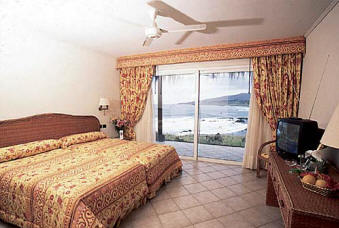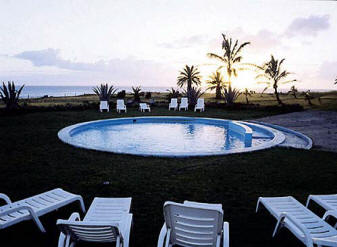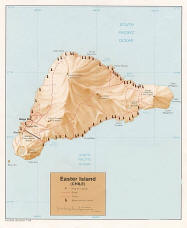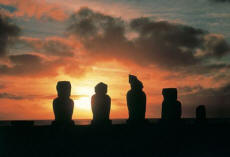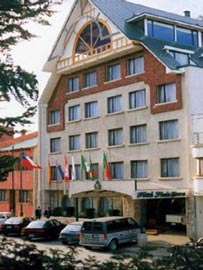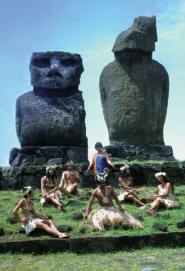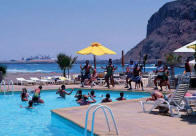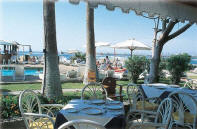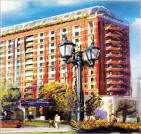Easter Island (Rapa Nui: Rapa Nui ("navel of the world");
Polynesian: Te Pito o te Henúa ("Navel of the World") or Mata-ki-te-Rangi
("Eyes [Speaking] from the Heavens"); Spanish: Isla de Pascua)
is an island in the south Pacific Ocean, a territory of Chile.
Located 3600 km (2,237 statute miles) west of continental Chile
and 2075 km (1290 statute miles) east of Pitcairn Island, it is
the most isolated inhabited island in the world. It is located
at 27°09′S 109°27′W, with a latitude close to that of the
Chilean city of Copiapó, north of Santiago. The island is
approximately triangular in shape, with an area of 163.6 km² (63
sq. miles), and a population of 3791 (2002 census), 3304 of
which live in the capital of Hanga Roa. The island is famous for
its numerous moai, the stone statues now located along the
coastlines. Administratively, it is a province (containing a
single municipality) of the Chilean Valparaíso Region. The
standard time zone is six hours behind UTC/GMT (five hours
behind including one hour of the daylight saving time).
History
Oral traditions and early history
Early European visitors to Easter Island recorded the local oral
traditions of the original settlers. In these traditions, Easter
Islanders claimed that a chief Hotu Matu'a ("the Great Parent")
arrived on the island in one or two large canoes with his wife,
six sons and extended family. There is considerable uncertainty
about the accuracy of this legend as well as the date of
settlement. Published literature suggests the island was settled
around AD 300-400. This date range is based on
glottochronological calculations and on three radiocarbon dates
from charcoal that appears to have been produced during forest
clearance activities. (Diamond 2005:89)
The Polynesians, who settled the island are likely to have
arrived from the Marquesas islands from the west. These settlers
brought bananas, taro, sweet potato, sugarcane, and paper
mulberry, as well as pigs, chickens, and rats. The island at one
time supported a relatively advanced and complex civilization.
European contact with the island began in 1722 on Easter Sunday
when Dutch navigator Jakob Roggeveen found about 2,000-3,000
inhabitants on the island, although the population may have been
as high as 10,000-15,000 only a century or two earlier. The
civilization of Easter Island was long believed to have
degenerated drastically during the 100 years before the arrival
of the Dutch, as a result of overpopulation, deforestation and
exploitation of an extremely isolated island with limited
natural resources, some evidence to support that the island had
a sudden collapse is the oral traditions of the islanders are
obsessed with cannibalism, to severly insult an enemy one would
say "The flesh of your mother sticks between my teeth", which
would suggest that the food supply of the people ultimately ran
out; however, this extreme view was based on subjective
interpretation of scientific evidence. All that can be said is
that there was a massive, anthropogenic alteration of the
ecosystem, and subsequently a cultural transition, but it was
very likely not the catastrophic event it was long believed to
be. By the mid-19th century the population had recovered to
about 4,000 inhabitants. Then in a mere 20 years, deportation to
Peru and Chile and diseases brought by Westerners almost
exterminated the whole population, with only 110 inhabitants
left on the island in 1877. It is more likely these events whose
recollection by the descendants of the survivors have led to
belief that they described ancient memories of a pre-contact
collapse. Easter Island was annexed for Chile in 1888 by
Policarpo Toro. The native Rapanui have since gradually
recovered from this low point in their numbers.
Today
Until the 1960s, the surviving Rapanui descendants were forced
to live in a confined settlement in squalid conditions at the
outskirts of Hanga Roa. Since finally being allowed to live
free, they have re-embraced their ancient culture, or what could
be reconstructed of it. A yearly cultural festival, the Tapati
celebrates native pastimes.
Rapa Nui is not the island's original name. It was coined by
labour immigrants from Rapa in the Bass Islands, who likened it
to their home island. The Rapanui name for Rapa Nui was Te pito
o te henua (The Navel of the World) due to its isolation, but
this too seems to have been derived from another location,
possibly a Marquesan landmark.
Recent events have shown a tremendous increase of tourism on the
island, coupled with a large inflow of people from mainland
Chile which threatens to alter the Polynesian identity of the
island. Land disputes have created political tensions since the
1980s, with part of the native Rapanui opposed to private
property and in favor of traditional communal property (see
Demography below).
The Moai
Main article: Moai
Moai in Hanga Roa, with Chilean Navy training ship Buque
Escuela Esmeralda cruising behind. This moai is currently the
only one with replica eyes
A MoaiThe large stone statues, or moai, for which Easter Island
is world famous were carved during a relatively short and
intense burst of creative and productive megalithic activity.
Archeologists now estimate that ceremonial site construction and
statue carving took place largely between about AD 1100 and
1600, with some statues probably still being carved at about the
time Jacob Roggeveen discovered the island. According to recent
archaeological research 887 monolithic stone statues, called
moai, have been inventoried on the island and in museum
collections. This number is not final, however. The on-going
statue survey continues to turn up new fragments, and mapping in
Rano Raraku quarry (see below) has documented more unfinished
statues than previously known. In addition, some statues
incorporated into ceremonial site construction surely remain to
be uncovered. Although often identified as "heads", the statues
actually are heads and complete torsos. Some upright moai,
however, have become buried up to their necks by shifting soils.
Most moai were carved out of a distinctive, compressed volcanic
ash or tuff found at a single site called Rano Raraku. The
quarry there seems to have been abandoned abruptly, with
half-carved statues left in the rock. However, on closer
examination the pattern of use and abandonment is more complex.
The most widely-accepted theory is that the statues were carved
by the ancestors of the modern Polynesian inhabitants (Rapanui)
at a time when the island was largely planted with trees and
resources were plentiful, supporting a population of
10,000-15,000 native Rapanui. The majority of the statues were
still standing when Jacob Roggeveen arrived in 1722. Captain
James Cook also saw many standing statues when he landed on the
island in 1774. By the mid-19th century, all the statues had
been toppled, presumably in internecine wars.
Rongorongo
Tablets found on the island and bearing a mysterious script
known as Rongorongo have never been deciphered despite the work
of generations of linguists. In 1932 Hungarian scholar Wilhelm
or Guillaume de Hevesy called attention to apparent similarities
between some of the rongorongo characters of Easter Island and
the prehistoric script of the Indus Valley in India, correlating
dozens (at least 40) of the former with corresponding signs on
seals from Mohenjo-daro. This correlation was re-published in
later books, for example by Z.A. Simon (1984: 95), but later
works showed these comparisons to be spurious.
Some writers have asserted rongorongo means peace-peace and that
their texts record peace treaty documents, possibly between the
long ears and the conquering short ears. However, such
explanations have been strongly disputed, particularly since the
"long-ear/short ear" designations of historical islanders have
become increasingly unsupportable.
Like most indigenous tellers of Easter Island histories or
legends, islanders continue to have questionable motives for
their accounts and have always been creative, imaginative and
quick to give answers to inquisitive archaeologists and
historians. Rongorongo's purpose and intent remain as puzzling
as the script's meaning. While there have been many claims of
translation, none have withstood peer review. S.R. Fischer has
reportedly made the most extensive study of Rongorongo to date
and in his book Glyphbreaker he claims to be the first to
successfully decypher it. However, to date no one has been
proven to have successfully deciphered this text.
|
|
Background:
|
A three-year-old
Marxist government was overthrown in 1973 by a dictatorial
military regime led by Augusto PINOCHET, who ruled until a
freely elected president was installed in 1990. Sound economic
policies, first implemented by the PINOCHET dictatorship, led to
unprecedented growth in 1991-97 and have helped secure the
country's commitment to democratic and representative
government. |
|
Location:
|
Southern South
America, bordering the South Atlantic Ocean and South Pacific
Ocean, between Argentina and Peru |
|
Geographic coordinates:
|
30 00 S, 71 00 W
|
|
Map references:
|
South America
|
|
Area:
|
total:
756,950 sq km
land: 748,800 sq km
note: includes Easter Island (Isla de Pascua) and Isla
Sala y Gomez
water: 8,150 sq km |
|
Area - comparative:
|
slightly smaller
than twice the size of Montana |
|
Land boundaries:
|
total:
6,171 km
border countries: Argentina 5,150 km, Bolivia 861 km,
Peru 160 km
|
|
Coastline:
|
6,435 km |
|
Maritime claims:
|
contiguous
zone: 24 NM
territorial sea: 12 NM
continental shelf: 200/350 NM
exclusive economic zone: 200 NM |
|
Climate:
|
temperate; desert
in north; Mediterranean in central region; cool and damp in
south |
|
Terrain:
|
low coastal
mountains; fertile central valley; rugged Andes in east |
|
Elevation extremes:
|
lowest point:
Pacific Ocean 0 m
highest point: Nevado Ojos del Salado 6,880 m
|
|
Natural resources:
|
copper, timber,
iron ore, nitrates, precious metals, molybdenum, hydropower
|
|
Population:
|
15,498,930 (July
2002 est.) |
|
Age structure:
|
0-14 years:
26.9% (male 2,127,696; female 2,033,201)
15-64 years: 65.6% (male 5,070,476; female 5,103,490)
65 years and over: 7.5% (male 482,846; female 681,221)
(2002 est.) |
|
Nationality:
|
noun:
Chilean(s)
adjective: Chilean |
|
Ethnic groups:
|
white and
white-Amerindian 95%, Amerindian 3%, other 2% |
|
Religions:
|
Roman Catholic
89%, Protestant 11%, Jewish NEGL% |
|
Languages:
|
Spanish |
|
